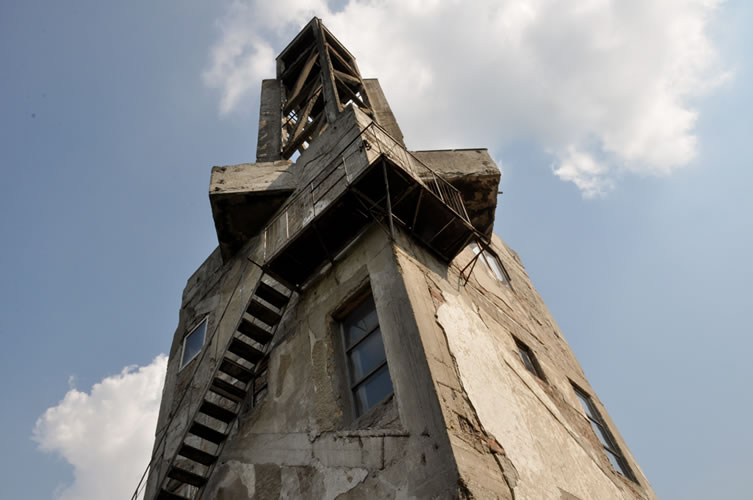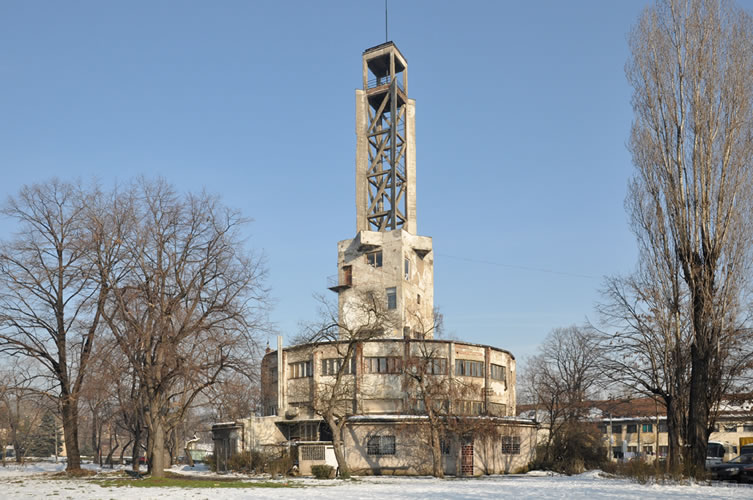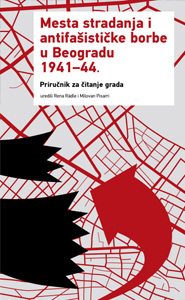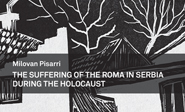This article by Rena Jeremić Rädle was published originally at Imre Kertész Kolleg’s Cultures of History Forum
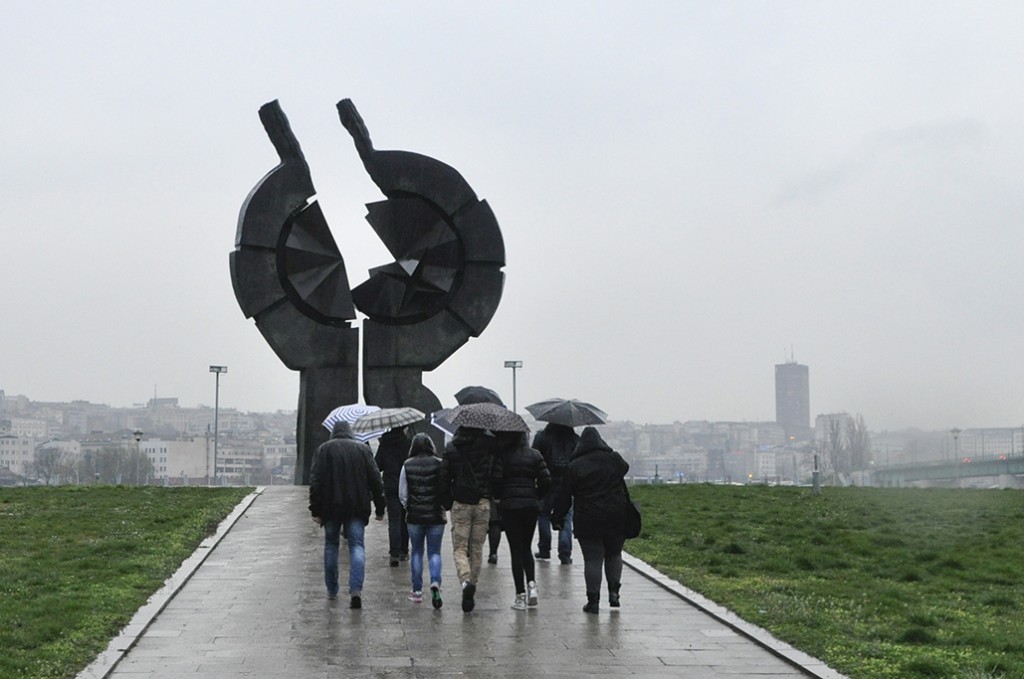
Monument to the victims of genocide at Sava river bank
Introduction
There is barely a hint nowadays that the buildings across from the most popular shopping mall in downtown Belgrade once housed the biggest fascist concentration camp in Serbia. Only the attentive observer will notice the derelict tower on the banks of the Sava with rundown modernist pavilions clustered around it. The pavilions are part of the former trade fair grounds (Sajmište). These days you can play soccer there, go out to eat at a restaurant, or even buy a car. The pavilion that once served as a camp hospital can now be rented out for various festivities. The squat barracks at one time provided a home for the city’s poor. Volunteer brigades moved into the abandoned buildings immediately after World War II, and later on, homeless people and artists moved in. Initiatives to establish a memorial site and exhibition like the kind set up in 1969 in Banjica, the other big camp in Belgrade, have all been fruitless. How can it be that all attempts to create an appropriate place of collective memory at this Holocaust site that was also the site of brutal repression against political prisoners and civilians from the whole of Yugoslavia have failed?
Historical context
With the invasion of the Kingdom of Yugoslavia on 6 April 1941, the territory of Yugoslavia was divided up between the fascist allies of Germany, Italy, Hungary and Bulgaria. The site of the Belgrade international trade fair (Sajmište), opened just a few years earlier, was turned into a “Jew camp” by the German Gestapo, and in 1942, its inmates were murdered in mobile gas vans. Hence, Serbia was one of the first occupied countries where the so-called “final solution” was implemented.1 The occupation authorities subsequently repurposed the empty pavilions into “holding camps” (Anhaltelager) for detaining members of the antifascist resistance along with civilians. Prisoners came from Serbia, from insurgent areas of the Independent State of Croatia, and finally from all of Southeastern Europe, the majority of which were later deported from Sajmište to Mauthausen, Auschwitz, and labor camps in Norway and Greece. The largest group of prisoners was made up of civilians from Bosnia who were captured during the German Kozara offensive against partisans in the fascist Independent State of Croatia.2
The following will show how state policies of remembrance and evermore powerful social groups have since dealt with the complex legacy of the Sajmište camp. Conflicting interests become evident in interpreting the history of the camp, effectively preventing any institutionalized memorial at the site.3 This text will serve as an overview of the changes in the official policies of remembrance in Yugoslavia and Serbia in terms of their relationship to the two most important ideological reference systems used in interpreting World War II: the narrative of antifascism and the narrative of the Holocaust. These changes took place in several stages. The decades after liberation, up until 1980, were marked by the unchallenged hegemony of the antifascist resistance as the reference point of commemoration. As of 1980, a new paradigm began to establish itself. It centered on the victims of genocide and was later instrumentalised for propaganda purposes with the outbreak of the Yugoslav wars; particularly, in the conflict with Croatia. From 2000 on, a new interpretation of World War II was institutionalized in Serbia. The establishment of a memorial site at the former Sajmište camp now seems close at hand.
World War II in the culture of memory of Yugoslavia
Socialist antifascism, which postulates “brotherhood and unity,” served as the foundation of the socialist Federal Republic of Yugoslavia after liberation from the Nazis. The internationalist partisan movement’s “war of national liberation” against fascist occupiers was part of the founding narrative. Their struggle included resistance to those who collaborated with the Germans – the occupiers having set up fascist, or at the very least, anticommunist governments in all areas of Yugoslavia after the April War of 1941. In Serbia, it was the puppet regime of Prime Minister Milan Nedić, which was put into power by the Germans. Also fighting against the insurgent partisans were the monarchist Četnik movement led by Dragoljub Mihailović, which envisioned a Greater Serbia within the Kingdom of Yugoslavia, and the Zbor fascist movement led by Dimitrije Ljotić. The Serbian areas Bačka and Banat located north of the Danube were divided between Germany and Hungary and policed by local ethnic Hungarian and German collaborators. The Srem region situated between the Danube and Sava fell to the Independent State of Croatia that was founded during occupation; and in this instance, Mussolini and Hitler had put the local fascist Ustaša movement directly in power, with Ante Pavelić as head of state.
The concept of antifascism in the postwar decades was inextricably linked to the experience of having fought together for the emancipatory project of a socialist Yugoslavia of brother nations. The socialist culture of remembrance was focused on the narrative of the combined resistance of the exploited class that neither ethnic nor religious differences could undermine. Until the late 1970s, Yugoslavia’s official policy of remembrance made reference neither to the Holocaust nor to the genocide of Roma and Serbs at Ustaša camps like Jasenovac, Croatia. The official commemorative ceremonies organized by SUBNOR, the Yugoslav veterans association, were always kept ethnically neutral. Only in exceptional cases were the number and identity of victims indicated on commemorative plaques.
The years of reconstruction in Belgrade after World War II were marked by a sense of optimism that was diametrically opposed to the horrors of the camps. Given its ideal location on the banks of the Sava right across from Old Town, the building contractors and volunteer youth brigades moved into the former camp grounds at Sajmišteand used it as their headquarters for erecting New Belgrade. The ambitious, though never fully realized, objectives of city planners from the 1960s and 1970s for the new city center (complete with a river promenade, museums, cinemas, and even an opera house), suggest that the memory of the horrors of war had receded into the distant past for the majority of the city’s population. Despite the energetic initiatives of former political prisoners in the veterans’ association which they presented to the Belgrade City Council in 1959, there was no plaque or monument identifying the site of the former Sajmište camp.4 The idea and hope of transcending the horrors of the past through art and culture is evident in the City Council resolution of 1951. When the building contractors moved out, artists were allowed to move into the fair pavilions, however poorly suited these facilities were for living and working in.5 Some of the artists, such as Olga Jevrić, made the unspeakable suffering of prisoners and the destruction and annihilation of the twentieth century the central theme of their work, thus helping in their own way to preserve the memory of this location.6 And yet, not until 1974 did an unknown hand place a commemorative plaque on one of the buildings.7 The plaque mentions the official figure of 40,000 victims, a figure arrived at by the State Commission for Investigating the Crimes of the Occupiers and their Accomplices (dissolved in 1948), but no further information is given about the reason for their murders. The perpetrators, on the other hand – the German Gestapo and their Yugoslav collaborators – are clearly identified. Neither the local Jewish community nor the former political prisoners section of the veterans’ association were asked to assist in creating the plaque.8
Discontinuities in the interpretation of the war of national liberation
New initiatives led to the declassification of documents at the State Commission for Investigating the Crimes of the Occupiers and their Accomplices, which had been kept under wraps for 30 years. A large-scale Yugoslavian research project entitled, “Yugoslavs in fascist prisons, detention centers and concentration camps, and the resistance movements of other countries in the Second World War” was launched in 1982. The project included research by historian Milan Koljanin, who worked with former prisoners and used the newly available documents to reconstruct the complicated history of the camp and to identify the various victim groups and transports. In his monograph The German Camp at the Belgrade Trade Fair Grounds, 1941–1944, he adjusted the previous number of estimated victims, arriving at a lower figure. Instead of 40,000, Koljanin estimated that the number of victims was somewhere in the range of 10,000.
A revived interest in the camps gave new impetus to the former prisoners, organized in the veterans’ association, who demanded that the Sajmištecamp be commemorated in a dignified way. Their commitment was reinforced by their aim to convey to younger generations the revolutionary antifascist tradition and oppose “the renascent [nationalist] movements of the counterrevolution,” as documented in a number of the association’s resolutions.9 The commemorative ceremonies held on 9 May, Victory Day over Fascism, in conjunction with the new memorial plaque in 1984 were, in retrospect, the last public manifestations of a communist-antifascist culture of remembrance. In 1987, the trade fair grounds were finally listed as a historical monument by the City of Belgrade, and a resolution was passed to create a clearly visible monument.10 The Sajmišteconcentration camp was to be turned into a memorial site of national importance like the one in Jajinci.11 It took until 1995, however, for the massive bronze sculpture to finally be unveiled – and under completely different auspices.
A radical reinterpretation of the war of national liberation began to emerge in the 1980s among anticommunist intellectuals throughout Yugoslavia. A new concept of antifascism was taking shape among opposition forces in Serbia, one that was no longer exclusively linked to the activities of communist partisans. The role of Nazi collaborators was being reevaluated. The fight against communist partisans by parts of the Četnik movement on the side of the German occupying forces were now seen as truly “antifascist and patriotic” and no longer deemed “treasonous,” and the war crimes of Četniks against Bosnian Muslims were suddenly relativized. The decoupling of antifascism from communism paved the way, on a rhetorical level, for the nationalist revision of this historical period and was a boon to propagandists in the run-up to the Yugoslavian civil war of the 1990s.12
The discontinuities in the narrative of a collective antifascist struggle caused analogous discontinuities in the perception of the collective victims of fascism. The 1986 memorandum of the Serbian Academy of Sciences in which the Serbian people are described as victims of Tito’s policies and the target of permanent genocide in Kosovo, fostered the creation of a myth of Serbian victimhood and its instrumentalisation by nationalist intellectuals. During these years, Yugoslav historians who were writing about World War II began to use the word “genocide” alongside such terms as “crimes” and “massacre”.13 Two years earlier, an increasingly radical-nationalist committee was founded at the Serbian Academy of Sciences with the aim of “researching the genocide against the Serbian and other peoples of Yugoslavia.”
In 1992, at the instigation of the same committee and with the support of the government in Belgrade, the decision was made to establish the Museum of the Victims of Genocide at the site of the Sajmištecamp. Museum representatives referred to it as a “Serbian Yad Vashem.” The fact that the camp set up and run by German occupation authorities was located on the opposite bank of the Sava, and hence on the territory of what was then the Independent State of Croatia, seemed proof enough for the museum’s founders that the Sajmište camp, like the Jasenovac and Jadovno camps, was a place of genocide against Serbs, Jews and Roma by Croatian Ustaša fascists. This version also had the advantage of exonerating the Serbian collaborators of their shared responsibility for the Holocaust perpetrated against the inmates of the Sajmište concentration camp. The urgency of such a museum must be viewed against the efforts of Croatian nationalist historians and intellectuals to relativize, for their part, the genocide against the Serbs in World War II. Advocates of this version of history, laying the blame for the suffering of Serbs and Jews primarily at the feet of (Catholic) Croatians, found support in the ranks of the Serbian Orthodox church as well as the Society for Serbian-Jewish friendship.14
The museum was never opened at the site, but is officially housed at the Twenty-First of October Museum in Kragujevac, dedicated to the victims of reprisals carried out by the German Wehrmacht. Nonetheless, Sajmište became a public symbol for the suffering of Serbs in Croatia. In 1995, the aforementioned monumental sculpture, chosen in 1987 and dedicated to all victims of genocide, was erected on the river promenade. The fact that just a few days after the monument’s unveiling, on 1 May the Croatian military launched operation “Bljesak” to reconquer Slavonia (and with it Jasenovac, triggering the expulsion of Croatian Serbs), underscores the symbolic power and political explosiveness of this place of memory. The inscription15 on the bronze plaque, presumably a compromise between the former prisoners section of the veterans’ association and the director of the Museum of the Victims of Genocide Milan Bulajić, is exemplary for the selective use of history and for the conflicts and contradictions between victim groups. The text introduces a notion of “Serbs, Jews and Roma” still common today, in which the victims of the Holocaust are not distinguished from the victims of other genocides. The monument also commemorates victims who were not murdered at the Sajmište camp, but on Croatian or Hungarian-controlled territory. Croatian Ustaša and Hungarian occupiers thus became a focus of attention as perpetrators. Unlike the inscription on the plaque from 1974, Sajmište is not described as a German or Gestapo camp, but as a Nazi one. And there is no longer any talk of “collaborators,” “traitors” or “accomplices of the occupiers.”
The institutionalization of the new narrative after 2000
The last decade has seen the institutionalization of Serbian-Orthodox and nationalist-anticommunist historical revisionism. The overthrow of Milošević in October 2000 was followed by the social normalization of national and clerical values. New books were printed for history classes, relativizing the role of Serbian collaborators and Četniks in Nazi crimes,16 and veterans of the Četnik movement were rehabilitated, being given the same legal status as communist partisans.17 A break in its state policy of remembrance came with Serbia’s membership in the International Holocaust Remembrance Alliance. In recognition of it becoming a member of this international organization, in 2012, the Serbian Institute for Modern History organized the first major exhibition on the Holocaust in Serbia with the support of various ministries and international institutions. The significance of this exhibit, which only ran for two months at the Museum of Yugoslavian History, can hardly be overestimated, as it was the first time the Jewish Holocaust was presented here as a singular crime, incomparable to other genocides. And yet problems of presenting history in a selective or suggestive manner were still evident. Thus, for example, the shared responsibility of the Serbian police and administrative apparatus for the Holocaust in Serbia was swept under the carpet, and the Jews were categorically described as the dominant economic force in society.18 This, notwithstanding Serbia’s joining the international alliance for Holocaust education and remembrance, marks the start of Serbia’s official policy of remembrance being integrated into the dominant Western narrative, focusing not on the antifascist resistance, but on the singularity of the Holocaust.
The struggle for the Sajmište memorial
The heated discourse about the Serbian victims of genocide has lost much of its explosiveness since the downfall of Milošević in 2000, especially considering that large parts of institutionalized historiography have now begun to identify the ethnicity of the victims. At the same time, the symbolic location of this struggle for recognition of Serbian victims, the Sajmište camp, has since become more attractive to investors and city planners. The emerging commercialization of the site in the late 1990s urged representatives of various social groups to formulate proposals for a memorial complex. In recent years, there have been several waves of initiatives at various levels of the city administration introducing concrete measures to resolve the legal and administrative hurdles to construction and renovation at the site. A specialist committee, convened by the city mayor, drafted a paper in 2013 on the proposed thematic and programmatic concept of the memorial site. With the change of government in Serbia, the program commission was disbanded and then newly-formed in 2014 under the leadership of Jovan Ćulibrk, a clergyman and member of the Jasenovac Committee of the Serbian Orthodox Church.
Discussions about the memorial site have yielded a variety of different ideas, but each model shares the idea of an educational mission, including exhibitions, a library, a documentation center and seminar rooms. Strong differences of opinion exist with regard to which institution the “Sajmište Memorial Center” should be subordinate to. The concept of a non-state-run “Museum of Tolerance,” which the commercial broadcaster b92 and its former director Veran Matić propagated in the media for years (even introducing a logo in 2010 and an architectural design by Daniel Libeskind), has meanwhile fallen by the wayside. The memorial site will in all likelihood be founded at the ministerial level, giving reason to believe that the museum will be managed by the Museum of the Victims of Genocide, now in its twentieth year of existence. Another open question is what role the Jewish community will be allowed to play in the organizational concept. A major point of contention is whether the Jewish community can directly access funds from the restitution of Jewish property, should the law of restitution be passed. The current president of the Union of Jewish Communities in Serbia, Ruben Fuchs, has demanded that a Holocaust museum be set up at the site in its own separate building.
Whatever narratives the future memorial site will convey, the ideological reference system of remembrance predominant nowadays, which insists on representations of the ethnic, religious, national, sexual, etc. individuality of victims, will undoubtedly expose the difficult relationship between a majority in Serbian society and the minorities of Roma and Jews. It is a relationship marked by instrumentalisation at the political level and marginalization at the social level. The Roma, socially marginalized both now and then, and largely ignored by historians, have the greatest difficulty fighting for the representation of their victimhood. Though the inclusive paradigm of the Serbian discourse of remembrance might pretend that “all victims of genocide” are equal, the remembrance of their “own” victims clearly has priority. An approach to history that not only duly commemorates victims, but also takes the perpetrators into account as well as the antifascist resistance, while at the same time questioning the social circumstances that led to fascist crimes in the first place, remains the task of critical forces in society and independent research.
1 Almost 7,000 Jewish women, children and elderly interned in the “Semlin Jew Camp” (Jevreijski logor Zemun) were asphyxiated in gas vans on the way from the camp to the mass grave in Jajinci, near Belgrade, between March and May of 1942. Their fathers, husbands and sons were shot to death in the fall of 1941 during the Wehrmacht’s “atonement campaigns” (Sühneaktionen). In occupied Serbia, a total of 15,000 Jews were murdered, which was about 80% of the overall prewar Jewish population there. See also: Milan Koljanin, Nemački logor na Beogradskom Sajmištu 1941-1944 [The German Camp at the Belgrade Trade Fair, 1941–1944], Belgrade: Institut za savremenu istoriju, 1992.
2 About 32,000 people were interned in the “Semlin Holding Camp” (Prihvatni logor Zemun), of which 10,636 did not survive. Milan Koljanin refers to this as a de facto concentration camp due to the conditions there.
3 Many factors and viewpoints in this debate about memory will not be handled in depth here for lack of space. For example, we will focus on policies of remembrance in Serbia, without concentrating on the parallel developments in Croatia. Moreover, the problem of internal victim hierarchies will not be addressed with regard to members and sympathizers of the communist resistance.
4 The section of the veterans’ association for former political prisoners, deportees and detainees played a key role in the efforts to maintain public awareness of the camp and its execution site in and around Belgrade. They also helped in collecting personal memoirs and documents about time spent in the camps. At that time there was still no literature about Sajmište, with the exception of a volume entitled Crimes of the Fascist Occupiers and their Accomplices against the Jews of Yugoslavia published by the Union of Jewish Communities in 1952. See: Jovan Byford, Staro sajmište. Mesto sećanja, zaborava i sporenja, Belgrade: Beogradski centar za ljudska prava, 2011.
5 Ljiljana Blagojević, “Grad kolektiva koji sanja i “konačno rešenje” in: Treći program broj 123-124, Radio Beograd, 2004.
6 Darko Tatić, ed., Beogradsko staro sajmište 3+1, Urbanistički zavod Beograda, Belgrade: 2008.
7 The inscription, borrowed for the commemorative plaque from 1984, went as follows: “In 1941, on the old trade fair grounds, the German Gestapo set up the ‘Sajmište’ camp where, with the help of local traitors, more than forty thousand people from various parts of our country were brutally tortured and murdered.” See also Byford, 2011, pp. 107-109.
10 The design of sculptor Miodrag Popović was chosen, who had previously come in second place for the Jajinci memorial park.
11 At the former shooting grounds of Jajinci, at the foot of Mount Avala, the Wehrmacht and SS liquidated about 65,000 camp inmates from the Belgrade concentration camps of Banjica, Sajmište, Topovske šupe and other smaller camps, before dumping the bodies in mass graves. They were later exhumed and burned during Sonderaktion (“Special Action”) 1005.
12 Slobodan Milošević and the Socialist Party of Serbia (SPS) which he founded, adopted this nationalized antifascist rhetoric from the ranks of the right-wing nationalist opposition. He used Serbian-Yugoslavian antifascism to legitimize his policy of defending regions in Croatia, Bosnia and Kosovo inhabited by Serbs against the new nation-states seceding from Yugoslavia, a policy which ultimately led to war. The right-wing nationalist opposition in the tradition of the Četniks under the leadership of Vuk Drašković and Vojislav Šešelj, rallied its followers – some of them in paramilitary units – around an extreme anticommunist position, which sociologist Todor Kuljić has referred to as anti-antifascism. See: Todor Kuljić, Umkämpfte Vergangenheiten, Berlin: Verbrecher Verlag, 2010.
13 The term genocide was introduced to Yugoslav historiography in 1972 by Vladimir Dedijer. On the influence of the Serbian Orthodox Church and the Serbian Academy of Sciences and the spread of the term genocide in the late 1980s see: Xavier Bougarel, Od krivičnog zakona do memoranduma, Političke perspektive, Belgrade: Fakultet političkih nauka, 2011.
14 There is not enough room in this brief overview to discuss the Serbian-Croatian propaganda war. On this and the instrumentalisation of the Holocaust in the Serbian polemic, see Jovan Byford, Staro sajmište. Mesto sećanja, zaborava i sporenja, Beograd: Beogradski centar za ljudska prava, 2011, pp. 149-151.
15 The inscription is as follows: “Here, on the trade-fair grounds, in the Nazi concentration camp that existed here during the occupation of 1941–1944, war crimes and genocide were perpetrated against approximately one-hundred thousand patriots, participants in the war of national liberation, against children, women and the elderly. Every second prisoner was murdered, in the camp or at execution grounds in Jajinci, Bežanijska kosa, Jabuka and Ostrovačka ada. Many were transported to German death camps throughout the whole of occupied Europe. Serbs, Jews and Roma suffered the most. This monument is dedicated to the victims of the notorious Ustaša camp in Jasenovac and the victims of Hungarian occupiers carried here downstream on the waves of the Sava and Danube, to the courageous resistance against Nazi terror, and to all Yugoslavian victims of genocide. Belgrade, the Day of Remembrance of the Victims of Genocide, April 22, 1995 and the 50th Anniversary of the Victory over Fascism.”
16 Kosta Nikolić, Nikola Žutić, Momčilo Pavlović, Zorica Špadijer, Istorija 3/4 za III razred gimnazije prirodno matematičkog smera i IV razred gimnazije opšteg i društveno-jezičkog smera, Belgrade, 2005.
17 Četnicima isto što i partizanima, Website of b92 (21 December 2004), retrieved 26 January 2011.
18 For a critique of the exhibit see Milovan Pisarri: Izložba o Holokaustu u Srbiji: problem selektivnog sećanja, retrieved 12. August 2015, URL: http://www.starosajmiste.info/blog/wp-content/uploads/2012/05/pisarri_selektivno_secanje.doc

